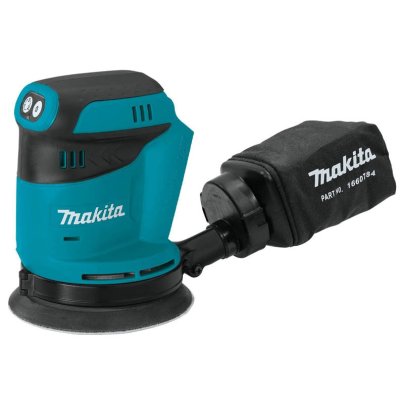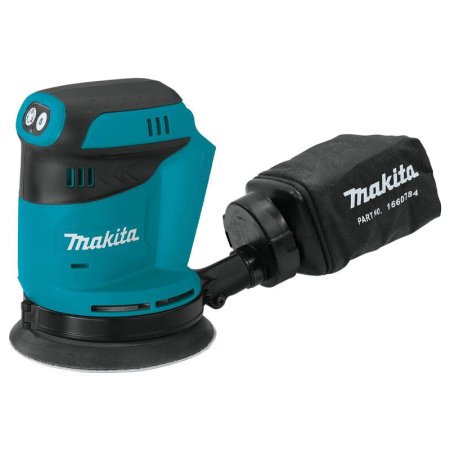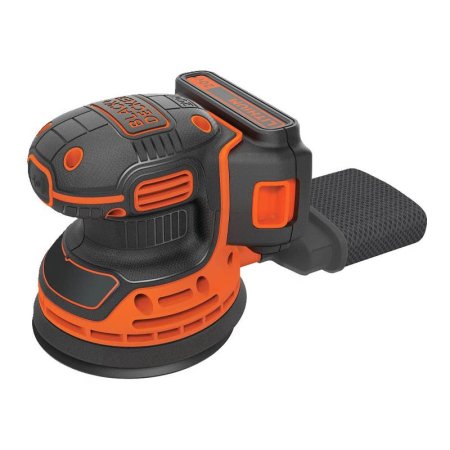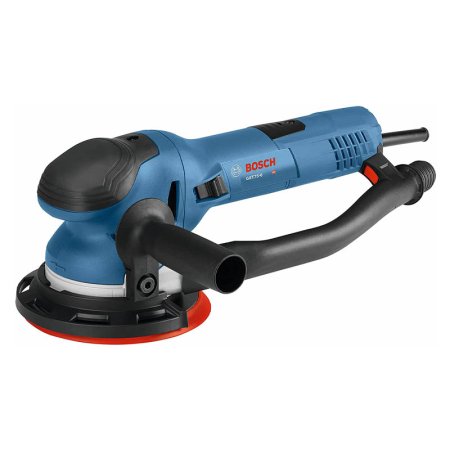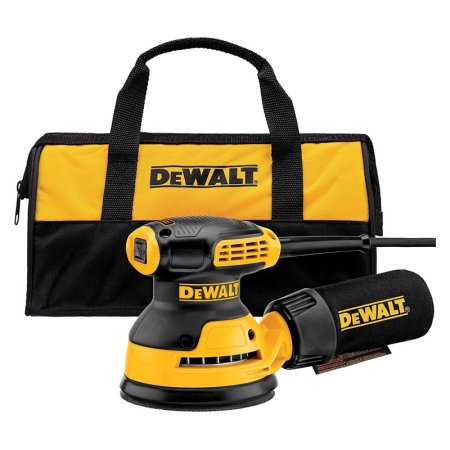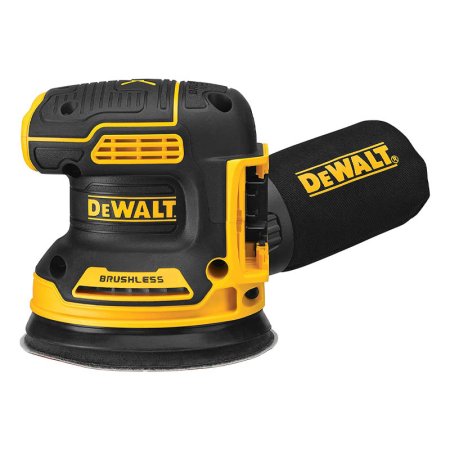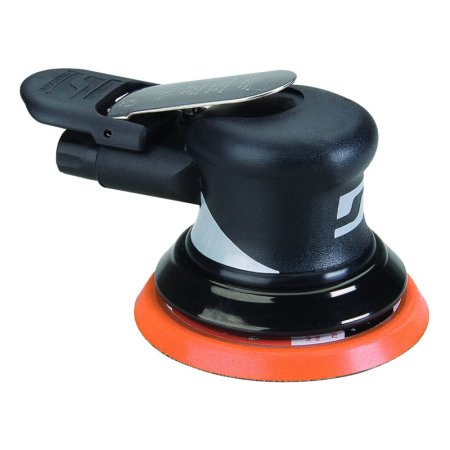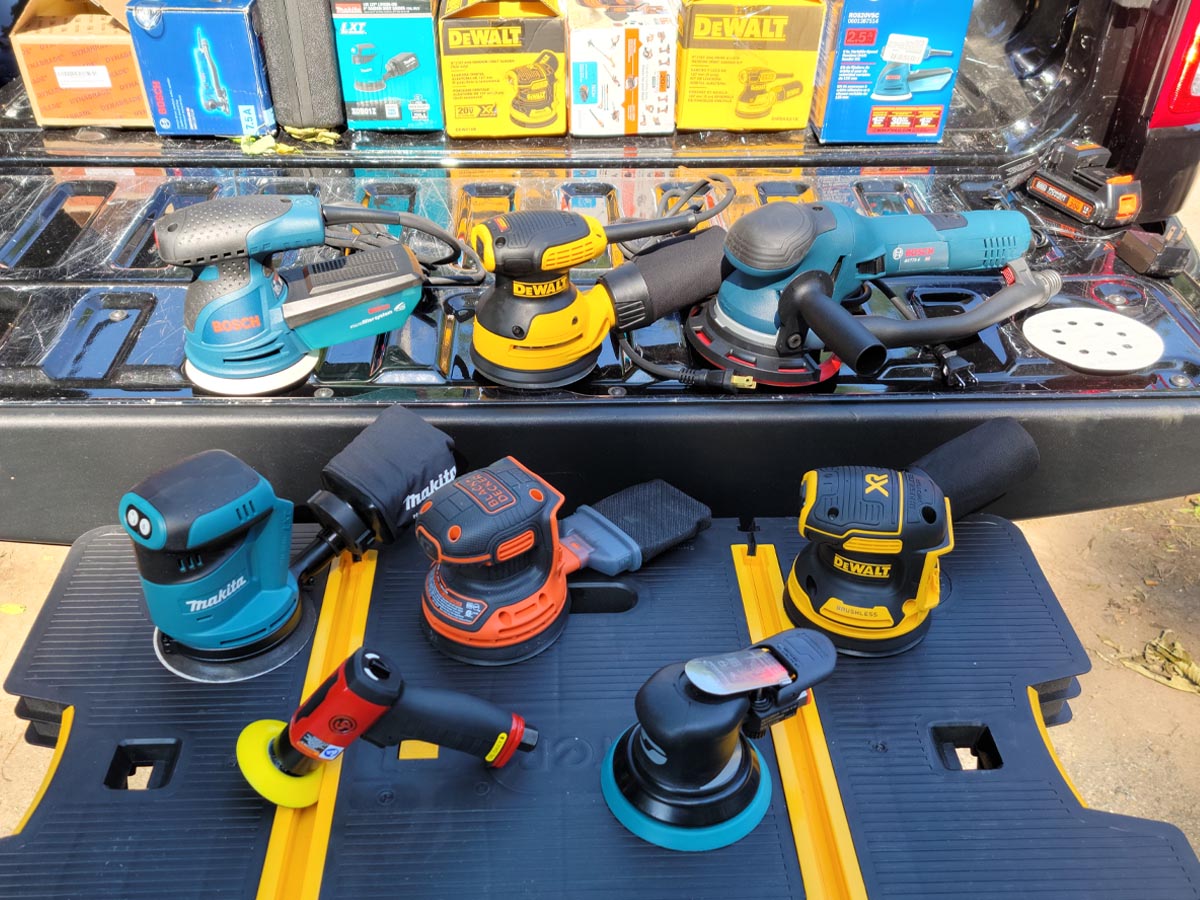
We may earn revenue from the products available on this page and participate in affiliate programs. Learn More ›
One of the first rules of woodworking is to sand in the direction of the wood grain to avoid creating cross-grain marks that compromise your home project’s finished look. But when a wood-grain pattern changes—for instance, on a parquet floor where grain direction varies from board to board—it’s difficult to sand without causing at least some blemishes.
In these situations, one of the best (and quickest) solutions is to use a random orbital sander—a power tool that features a sanding pad that simultaneously spins and oscillates (orbits) in an ellipse pattern. That magic combination of spinning and oscillating dramatically reduces sanding marks.
There are so many models on the market that choosing the best random orbital sander can feel overwhelming. But, there’s good news: We performed in-depth, hands-on testing with the following models to help point you in the right direction.
- BEST OVERALL: Makita Cordless 5″ Random Orbit Sander
- BEST BANG FOR THE BUCK: Black+Decker 20V MAX Cordless Random Orbital Sander
- UPGRADE PICK: Bosch 6″ Dual-Mode Random Orbit Sander
- BEST CORDED: DeWalt 5″ Single Speed Random Orbit Sander
- BEST CORDLESS: DeWalt Cordless Variable-Speed Random Orbital Sander
- BEST PNEUMATIC: Dynabrade 5″ Non-Vacuum Random Orbital Sander
- BEST FOR TIGHT SPOTS: Chicago Pneumatic CP7200S Mini Random Orbital Sander
- BEST PALM SANDER: Bosch 5″ Random Orbital Sander/Polisher
How We Tested the Best Random Orbital Sanders
Let’s just say the dust hasn’t settled since our test. We put all of these random orbital sanders through their paces to see what they could do.
First, our test simply consisted of putting each of the sanders together, and all the sanders passed the test. Next, we tested each model with 80- and 120-grit sandpaper against a few pieces of stained pine to determine how quickly they’d remove material as well as how well they’d remove scratches. Finally, we simulated sanding a door or another vertical surface by standing a board on edge.
These tests allowed us to evaluate each model’s speed, comfort, and long-term ease of use. We then gave each model an award based on its strengths, creating this list of the best random orbital sanders.
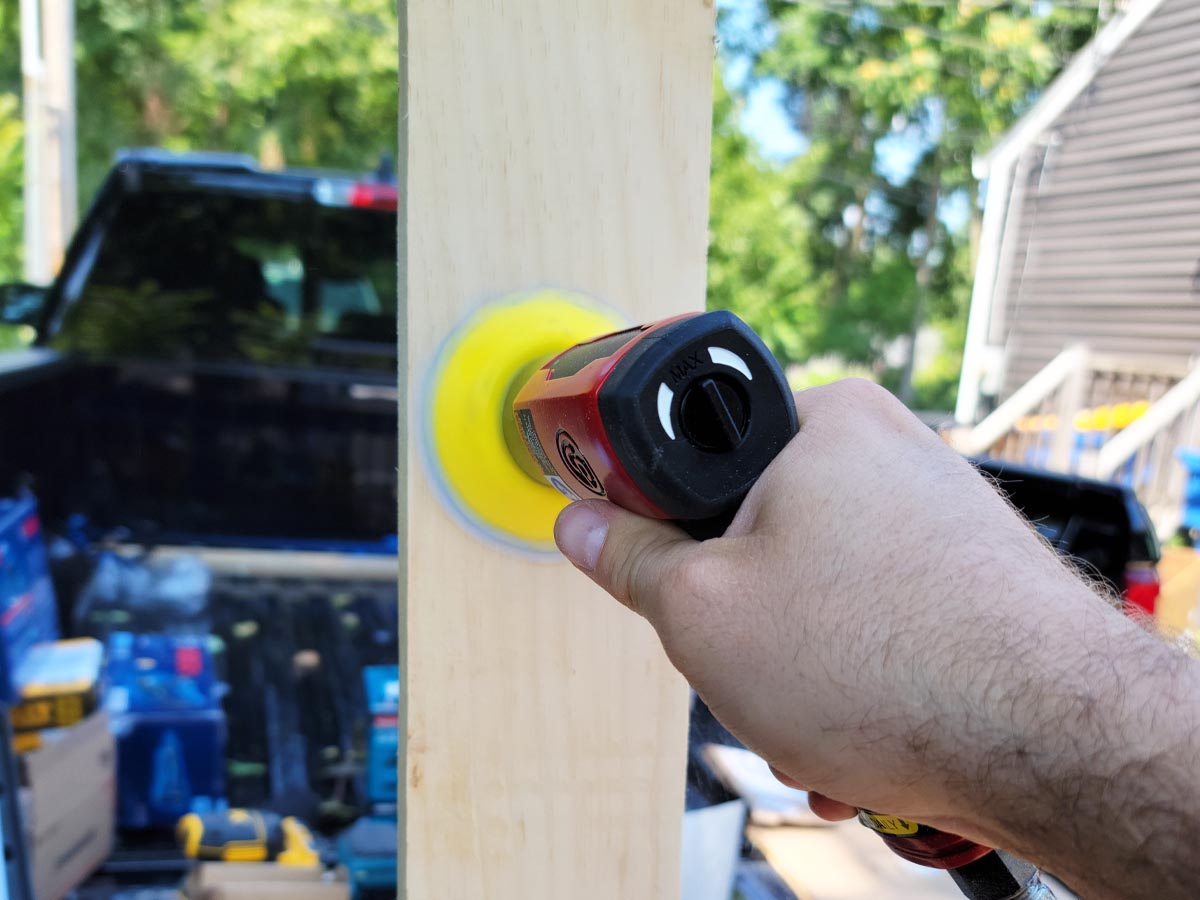
Our Top Picks
That’s a lot of information on the best random orbital sanders, and it can make a shopper’s head spin. To help, check out the following list of products compiled with the top considerations in mind. Be sure to consider the features necessary for a given situation when comparing one model to another.
Best Overall
Makita Cordless 5" Random Orbit Sander
What We Like
- Cordless portability allows for sanding anywhere
- Adjustable speeds for different materials and aggressiveness
- Comes with a large battery for a longer runtime
What We Don’t Like
- It’s a little tall for a palm sander
Product Specs
- Size: 5 inches
- Speed: 7,000; 9,500; and 11,000 opm
- Power source: 18V battery
This Bob Vila Approved product carries our brand’s highest level of recommendation.

Bob Vila Approved recognizes the household and DIY products that impressed us most in our real-world testing and that exemplify core values of the Bob Vila brand, including craftsmanship, innovation, and value for the dollar. Winners of this designation come recommended by our professional review team and are personally approved by Bob Vila.
When electrical outlets are scarce, or when there’s a need for free range of motion to complete a project, the variable-speed Makita 5-Inch Random Orbit Sander is worth a look. This sander uses the brand’s 18-volt (V) batteries, and it’s available with a 5.0 amp-hour (Ah) battery for up to 65 minutes of sanding on low speed and 32 minutes at high speed. It also comes with a charger and a carrying bag.
This sander features three adjustable speeds, including 7,000; 9,500; and 11,000 opm. While it doesn’t have an extra handle, it is (just) compact enough for one-handed use. Also, this model comes with a dust-collection bag and it uses hook-and-loop 5-inch 8-hole sanding discs.
We realized a few things while testing the Makita. First, we noticed that it was very smooth—the smoothest of all the cordless models. However, we also noticed that it is a bit tall compared to the others. We also found the buttons to be a bit confusing as they’re marked strangely: off is “0” while on/speed change is “1, 2, 3.” While that made speed adjustments a breeze, turning it off was confusing. However, we did like how the dust bag was easy to remove, preventing dust from shooting everywhere like other models.
Get the Makita random orbital sander on Amazon or at The Home Depot.
Best Bang for the Buck
Black+Decker 20V MAX Cordless Random Orbital Sander
What We Like
- 12,000-opm top speed
- Affordable price point
- Allows for quick sanding disc changes
What We Don’t Like
- Only 1 speed (but it is fast)
Product Specs
- Size: 5 inches
- Speed: 12,000 opm
- Power source: Cordless 20V battery
When it comes to sanding on a budget, the Black+Decker 20V Max Random Orbital Sander is tough to beat. This 5-inch sander comes with a 20V 1.5 Ah lithium-ion battery, a charger, and a detachable dust collection system. It weighs just over 3 pounds, and it features a molded-rubber grip for comfort and fatigue reduction.
The Black+Decker random orbital sander utilizes hook-and-loop sanding discs, allowing users to quickly replace a worn disc. While it’s just a one-speed sander (and that one speed is relatively high), quick swapping sanding discs does allow users to dial in the rate at which they’re removing finish or sanding the surface.
For the price, we found it very hard not to like the Black+Decker 20V sander. It might be slightly underpowered and the dust-collection bag is a bit underwhelming, but everything else is spot-on. The grip is comfortable and it has just the right amount of size and weight. It was one of the most comfortable models to use in the vertical-sanding test for those reasons. No, it doesn’t have variable speeds, but it definitely gets the job done.
Get the Black+Decker random orbital sander on Amazon or at Walmart.
Upgrade Pick
Bosch 6" Dual-Mode Random Orbit Sander
What We Like
- Multiple hand positions for better control and comfort
- Turbo mode for aggressive stock removal
- Built-in port for vacuum
What We Don’t Like
- It may be too heavy for smaller jobs
Product Specs
- Size: 6 inches
- Speed: 3,300 to 7,300 opm
- Power source: 7.5-amp corded motor
When it’s more about power and capability than portability, shoppers should consider the Bosch 6-Inch Dual-Mode Random Orbit Sander. This burly corded random orbital sander features a large design with multiple hand positions for control and comfort, including a removable handle that mounts on either side as well as a barrel grip and a molded hand pad on top. It uses 6-inch sanding discs and polishing pads.
This model features two modes: a random orbital mode and a turbo mode. The turbo mode maxes out at 7,300 opm and removes stock at five times the rate of the basic mode. Also, this sander features a built-in vacuum port to which users can hook up their shop vacuums or shop dust collection systems. It is a little expensive, but its capabilities make up for the price.
Here’s what we think of this random orbital sander from Bosch: It’s a beast. While the top speed might seem low, it has a big sanding disc and lots of torque. And, despite its power, it has a slow-start feature that prevented it from jumping in our hands upon start-up. It’s incredibly aggressive in Turbo mode but very easy to handle in standard mode. It might be a bit heavy for smaller jobs, but the weight helps it run smoothly and minimizes vibration (not in Turbo mode, though!).
Get the Bosch Dual-Mode random orbital sander at The Tool Nut.
Best Corded
DeWalt 5" Single Speed Random Orbit Sander
What We Like
- 12,000-opm high-speed sanding
- Great dust-bag design
- Lightweight and compact
What We Don’t Like
- Single-speed only
Product Specs
- Size: 5 inches
- Speed: 12,000 opm
- Power source: 3-amp electric
For those looking for a random orbit sander with continuous corded power, check out the corded DeWalt Single Speed Random Orbit Sander. The 5-inch sander comes with a detachable dust-collection bag for catching sawdust. It also comes with a soft carrying bag to keep things organized.
This 5-inch 4-pound sander’s 3-amp motor is designed for reduced vibration while also offering up to 12,000 opm of speed. This palm sander features a rubberized palm grip to further reduce vibration and increase comfort, making the tool easier to use over the duration of a project. However, do keep in mind that this sander has just one speed (and it’s a high one), so be sure to use the correct sandpaper at all times.
To be honest, we were kind of skeptical about comparing a single-speed random orbital sander to other models with more features and flexibility. However, this model from DeWalt proved more than worthy during our test. First, it felt lighter than the other corded models, and it was quite comfortable in hand thanks to its compact and low-profile design. The dust-collection bag worked well, and we found emptying it was very easy as it has a coiled spring inside that collapses to push dust out. The bag also has a collar that twists into place for a secure fit and easy removal. And while it only has one speed, that speed will be plenty for most users.
Get the DeWalt Single Speed random orbital sander on Amazon or at The Home Depot.
Best Cordless
DeWalt Cordless Variable-Speed Random Orbital Sander
What We Like
- Adjustable speeds for controlling aggressiveness
- Compact and lightweight design for control
- Offers cordless portability
What We Don’t Like
- Ours had a loose shroud
Product Specs
- Size: 5 inches
- Speed: 8,000 to 12,000 opm
- Power source: 20V battery (sold separately)
Any DIYers, woodworkers, or cabinetmakers—professional or weekend warrior—should check out the DeWalt Cordless Variable-Speed Random Orbital Sander. This 5-inch cordless sander features a compact design for ease of use as well as variable speeds between 8,000 and 12,000 opm for controlling aggressiveness on different surfaces. It also features a one-handed locking dust bag that allows the user to empty it fuss-free.
This sander utilizes 5-inch 8-hole hook-and-loop sanding discs, allowing for quick changes between grits or when one pad runs out. While this particular model doesn’t come with a battery or a charger, it’s compatible with the brand’s 20V Max battery lineup. This allows users already invested in DeWalt tools to take advantage of their stock of batteries.
The DeWalt cordless random orbital sander did not disappoint during our test. This model features DeWalt’s collared dust bag that is not only easy to take on and off but also simple to empty thanks to the coiled spring inside. We also liked this model’s size as it was light and compact but still provided lots of power when needed. It was also fairly smooth during use; however, the rubber shroud around the disc on our model was loose and rubbed the disc, but all it required was some fidgeting to get it back in place.
Get the DeWalt Variable-Speed random orbital sander at Amazon, The Home Depot, or Lowe’s.
Best Pneumatic
Dynabrade 5" Non-Vacuum Random Orbital Sander
What We Like
- Smooth operation
- Lightweight and easy to maneuver
- Lots of accessories available
What We Don’t Like
- Doesn’t come with a hook-and-loop pad
Product Specs
- Size: 5 inches
- Speed: Max of 12,000 opm
- Power source: Air
For anyone creating a workshop of pneumatic tools, the Dynabrade 5-Inch Non-Vacuum Random Orbital Sander will make a fine addition. This model utilizes air pressure instead of electricity, allowing users to take advantage of their compressors while leaving an extension cord on the shelf.
Weighing in at just 2.04 pounds, the Dynabrade random orbital sander is easy on the hands and lightweight enough to use for extended periods. It features a five-blade rotor for high-speed sanding capability (up to 12,000 opm), the speed of which changes with the air pressure exerted by the compressor. It also features an ergonomic palm grip and fits a standard ⅜-inch air compressor hose. Do keep in mind that it’s important to have a large compressor on hand, as air-powered random orbital sanders use a lot of air.
Dynabrade’s 5-inch random orbital sander is highly flexible, and that’s something we really liked about it. While our model didn’t come with a hook-and-loop pad for standard sanding discs, the vinyl-faced pad intended for pressure-sensitive discs contoured when we needed it to and then flattened out for straight, level sanding surfaces—just as one might expect for a sander designed for automotive use. While it was slightly loud (all air-powered tools are), it ran smoothly and felt substantial in hand despite being so lightweight.
Get the Dynabrade random orbital sander on Amazon.
Best for Tight Spots
Chicago Pneumatic CP7200S Mini Random Orbital Sander
What We Like
- Compact size makes reaching into small spaces easier
- Comes with 60 sandpaper discs and pads that can be swapped
- Includes a carrying case
- Speed changes are easy
What We Don’t Like
- Doesn’t fit in the carrying case with the hose adapter installed
Product Specs
- Size: 2 inches and 3 inches
- Speed: 15,000 opm
- Power source: Air
The Chicago Pneumatic CP7200S Mini Random Orbital Sander makes it easy to sand in tight spots. This single-speed mini sander features a molded-rubber trigger grip and weighs just 1.5 pounds. It is air-powered, meaning a compressor is necessary to run it, but it can run at speeds up to 15,000 opm.
Designed for small areas, the Chicago sander comes with interchangeable 2-inch and 3-inch backing pads and 60 sandpaper discs. The sander connects to a standard ⅜-inch air compressor hose, and it comes in a molded plastic case for storage. It also features a pistol-style grip.
Chicago Pneumatic’s mini random orbital sander was a blast to use during our test. First, the pistol grip was very comfortable. And, since it’s so lightweight, it was easy to use for extended periods of time—even vertically. Swapping between 2-inch and 3-inch pads is very easy, as are speed changes thanks to the dial on the back of the sander. The fact that it comes with so many discs and a carrying case is a serious bonus, but we noticed that ours wouldn’t fit back in the box with the hose adapter attached.
Get the Chicago Pneumatic random orbital sander on Amazon or at Walmart.
Best Palm Sander
Bosch 5" Random Orbital Sander/Polisher
What We Like
- Comfortable rubber grip
- Excellent air-filter design
- Affordable price point
- Easy to change speeds
What We Don’t Like
- It’s a little heavy for a palm sander
Product Specs
- Size: 5 inches
- Speed: 7,500 to 12,000 opm
- Power source: 2.5-amp corded motor
For light-duty sanding with an easy-to-control palm sander, check out the Bosch 5-Inch Random Orbital Sander/Polisher. This model features a corded design with a 2.5-amp motor, giving users continuous power without the need to manage battery life. It comes with a dust collecting cartridge as well as a built-in test port for vacuum connection.
This model from Bosch packs a lot of capability into a small package. It features variable speeds between 7,500 and 12,000 opm, allowing users to choose the best speed for the project. Despite being small, it uses 5-inch hook-and-loop sanding discs for plenty of surface area and quick changes in the middle of a project.
There is a lot to like about this sander from Bosch. Let’s start with the most impressive feature: the dust bag. This model’s dust-collection bag features an actual pleated air filter that allows air to pass through while catching dust particles. It also detaches easily without a cloud of dust blowing through the air. We also like the affordable price point, making it a steal (in our opinion). While we did think it felt a bit heavy compared to other cordless models, we liked the comfortable rubber grip and the fact that users could change speeds easily.
Get the Bosch 5-Inch random orbital sander/polisher on Amazon or at The Home Depot.
Our Verdict
For those looking for the best all-around random orbital sander, the Makita random orbital sander‘s portability, speed, and battery life are tough to deny. For those who’d prefer to save a bit of cash while still being able to sand their projects to a beautiful result, the Black+Decker random orbital sander’s price point compared to its features makes it a solid choice.
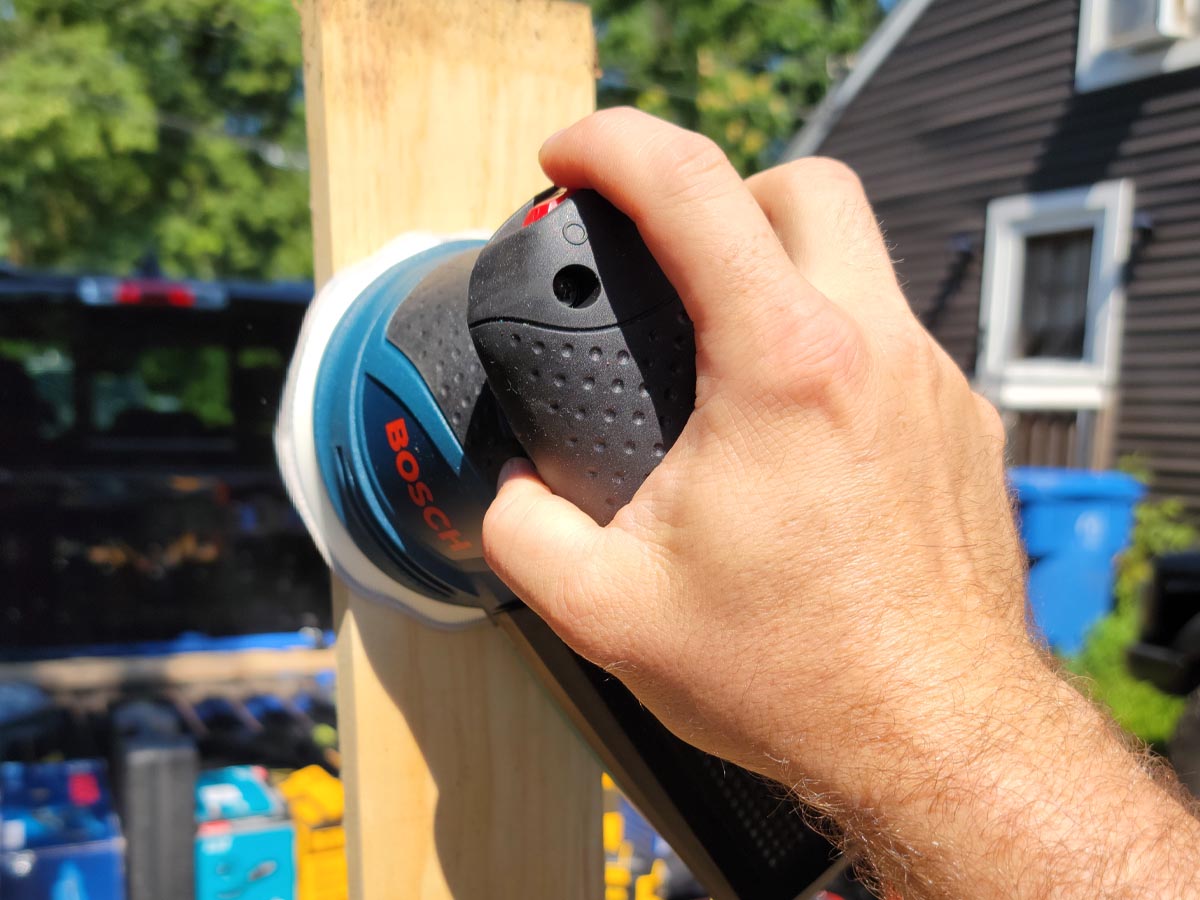
What to Consider When Choosing the Best Random Orbital Sander
When shopping for a random orbital sander, there are several features to keep in mind to help choose what best suits a given circumstance. Below are some of the most important considerations to keep in mind when comparing one model to another.
Speed Variations
Many random orbital sanders have a single speed, but some models feature variable speeds that alter the sander’s aggressiveness. A higher speed is helpful when quickly grinding down finishes and high spots (as when removing varnish from an old bookcase). A lower speed is better suited for fine sanding (to achieve a smooth surface on a tabletop, for example).
Also, understand that while most tools use revolutions per minute as their standard of speed, random orbital sanders use the term “opm,” which stands for oscillations per minute. Oscillation is essentially a revolution but with a random, oval path rather than a tight circle.
A lack of variable speeds shouldn’t be a deal breaker, however, as success can be achieved simply by using the appropriate sandpaper grit (coarse to deal with rough work, medium for smoothing, and fine for finish work).
Disc Size
The standard disc size for random orbital sanders is 5 inches in diameter, and there are a wide variety of generic 5-inch sandpaper discs in any hardware store or home improvement center. DIYers can also find sanders with smaller 1- to 4-inch discs that are handy for sanding in tight spots.
For larger projects (such as sanding a hardwood floor), 6-inch or larger discs are the best bet. Depending on the size and model of the sander, it may be necessary to purchase brand-specific sandpaper discs.
Dust Collection
Some random orbital sanders come with attachable dust bags that collect some of the wood dust generated while sanding. Others include attachments that can be connected to a standard wet/dry vacuum hose for dust collection. These collection methods won’t remove every speck of dust (always wear a dust mask when sanding), but they can greatly reduce it, so they’re good options to look for, especially when sanding indoors.
Power Options
Random orbital sanders are powered in one of three ways: electrical cords, rechargeable batteries, or compressed air (pneumatic). Each method has its benefits.
- Corded: Because there’s no battery to recharge, corded sanders are always ready to go as long as there’s an electrical outlet nearby. Just plug in the corded random orbital sander and get to work.
- Cordless: These sanders are great when sanding far from a power source, such as when building the kids a tree house without an extension cord long enough to reach. With a cordless sander, however, the battery’s charge is a limitation to be considered. Users will usually get 30 to 45 minutes on a single charge, and many keep a spare battery on hand to continue working while the first battery charges.
- Pneumatic: Powered by compressed air, pneumatic sanders are a good choice for the woodworker who has a central air compressor to power a number of air tools. Small, pancake-type air compressors, however, are not always powerful enough to run a sander without frequent stops to recharge with air. For the best results, use a pneumatic sander with an air compressor that can produce an air volume of 40 cubic feet per minute or higher.
Weight
A typical 5-inch random orbital sander weighs about 2 to 4 pounds. Mini sanders weigh as little as 1.5 pounds, while larger random orbital sanders can weigh 7 pounds or more. Lighter sanders create less hand and wrist fatigue, especially if sanding a vertical surface, such as wood paneling.
Extra Handle
Most random orbital sanders feature a top palm grip that makes it easy to maneuver with just one hand. If there’s going to be a lot of sanding in the future, however, it may be a good idea to go for a model with an additional side grip that allows two-handed control.
Some sanders and polishers also feature a barrel grip, similar to some jigsaws. The barrel grip allows the user to keep their hand closer to the work surface, improving leverage and control.
FAQs
Power sanders make quick work of smoothing rough trim, decks, railings, and virtually any other type of wood project, and random orbital sanders figure among the most popular types of sanders due to their ability to smooth wood without leaving telltale cross-grain marks. Those who are expanding their power-tool collection to include random orbital sanders will likely have a few questions.
Random orbital sanders employ two different types of motions: spinning and oscillating (moving in an elliptical fashion). The combination of these two sanding movements keeps the sander from leaving marks on the wood.
Orbital sanders simply spin. Random orbital sanders spin in addition to the entire sanding head moving in an elliptical pattern. Try holding a random orbital sander and then turning it on—your entire hand will want to move in an elliptical pattern. That’s due to the orbital force of the sander.
Random orbital sanders are used for primary sanding steps, such as removing coarseness or roughness from the wood surface. They are often followed up by sanding either with a finish sander or by hand with a fine-grit sandpaper.
No, but using a random orbital sander will help remove most of the roughness. A finishing sander can be used afterward to create a very smooth surface.
